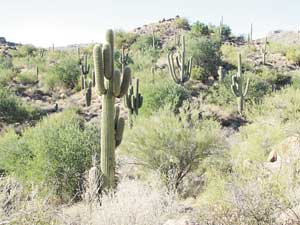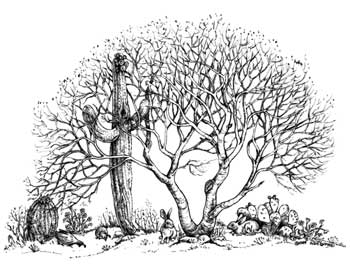BY THE DESERT AWARENESS COMMITTEE | ORIGINALLY PUBLISHED IN 1990
Learning to know the desert takes
time and patience
Your reward is a beautiful new experience
The following column was previously published in 1990 by the Cave Creek Improvement Association and was subsequently released again by the Desert Awareness Committee. Its content is still relevant as many areas of the Desert Foothills continue to be threatened.

Beautiful Sonoran Desert view on the Jojoba Trail at Bartlett Lake. Courtesy Photo/Dave Mills
What is most needed is a little patience, and openness to a new experience. The desert environment has its own wild beauty which comes to be appreciated more and more after living with it. The Sonoran Desert is unique among the deserts of the world for its great variety of vegetation and wildlife. Learning about this desert place and appreciating it before trying to change it is essential.
The tall saguaro is of course Arizona’s trademark – unique to the Sonoran Desert – and native and newcomer alike appreciate its stately beauty. But how many appreciate the lowly bursage? Tiny seedling saguaros, and many other desert plants, must have shade for the first several years of their lives, and it is usually the bursage that provides it. Bursage (also sometimes referred to as burr sage) has come to be known as the “nurse plant of the desert,” yet it is the first thing to go when people decide to “tidy up the land.”

Illustration by DAC member Nan Byrne
© 1989 Nan Byrne
There is a delicate balance of nature here that we would do well to learn before disturbing. The mesquite, ironwood and palo verde trees, the thorn bushes and cactus, the moths and other insects, the quail, rabbits, coyotes, foxes, deer, roadrunners and other birds, and even the rattlesnakes and scorpions live in a kind of natural balance with each other that is not always obvious. We learn to our sorrow that interfering with this balance often results in a destruction of the environment that was not intended. If human beings could have the humility to try to enter into relationship with nature and take their place alongside the other species that are already here, people surely would find it a more satisfying experience than attempting to control and exploit the environment. Humans are latecomers to this desert place. Let us in humility have patience, take time, and respect the land and the many forms of life already here. Learn, adapt, and enjoy.



